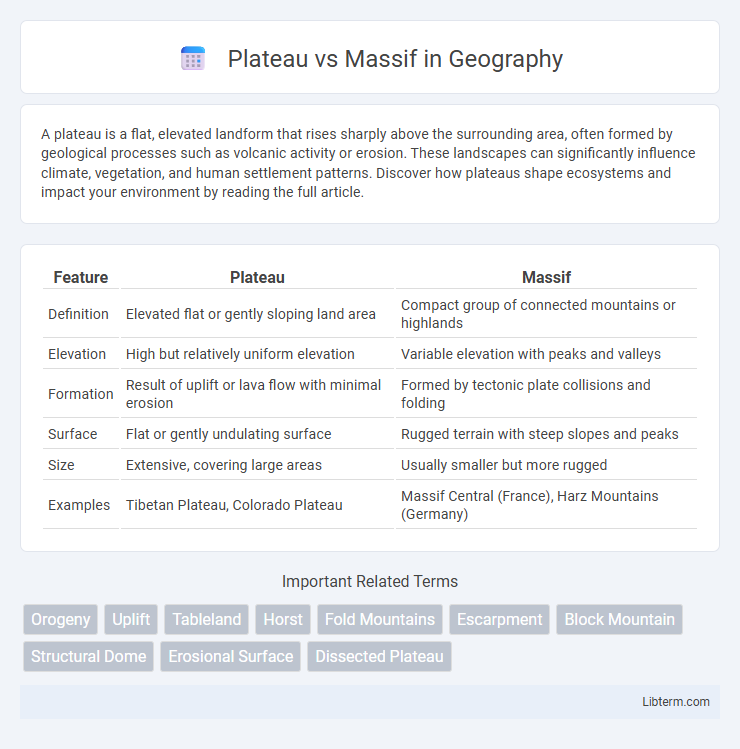A plateau is a flat, elevated landform that rises sharply above the surrounding area, often formed by geological processes such as volcanic activity or erosion. These landscapes can significantly influence climate, vegetation, and human settlement patterns. Discover how plateaus shape ecosystems and impact your environment by reading the full article.
Table of Comparison
| Feature | Plateau | Massif |
|---|---|---|
| Definition | Elevated flat or gently sloping land area | Compact group of connected mountains or highlands |
| Elevation | High but relatively uniform elevation | Variable elevation with peaks and valleys |
| Formation | Result of uplift or lava flow with minimal erosion | Formed by tectonic plate collisions and folding |
| Surface | Flat or gently undulating surface | Rugged terrain with steep slopes and peaks |
| Size | Extensive, covering large areas | Usually smaller but more rugged |
| Examples | Tibetan Plateau, Colorado Plateau | Massif Central (France), Harz Mountains (Germany) |
Introduction to Plateaus and Massifs
Plateaus are elevated flatlands that rise sharply above surrounding areas, often formed by volcanic activity or tectonic uplift. Massifs are compact groups of connected mountains, typically formed through tectonic forces that create rigid blocks of the Earth's crust. Both landforms significantly influence regional climate, vegetation, and human settlement patterns due to their distinct elevation and geological structure.
Defining a Plateau: Key Features
A plateau is an elevated flatland characterized by a relatively level surface rising sharply above the surrounding area. Its key features include significant elevation, flat or gently undulating terrain, and often steep cliffs or escarpments at its edges. Plateaus can form through tectonic uplift, volcanic activity, or erosion, distinguishing them from massifs, which are compact, structurally coherent mountain masses.
What is a Massif? Distinct Characteristics
A massif is a compact group of connected mountains or a section of a planet's crust that is delineated by faults or flexures, often forming a distinct structural unit in tectonic terms. Unlike plateaus, which are flat elevated terrains, massifs are characterized by rugged topography with peaks and valleys, resulting from intense geological folding and faulting. These formations often contain ancient rock layers and showcase significant elevation differences within a relatively confined area.
Formation Processes: Plateau vs Massif
Plateaus form primarily through the uplift of extensive flat-lying sedimentary layers or volcanic lava flows, often driven by tectonic forces or mantle plumes, resulting in broad, elevated flat regions. Massifs develop by the intense deformation and metamorphism of the Earth's crust during tectonic collision events, where large blocks of crust are uplifted and rigidly displaced, creating compact, structurally complex mountainous areas. The key difference lies in plateaus maintaining relatively horizontal strata versus massifs exhibiting highly folded and faulted rock formations due to deep crustal processes.
Geographical Distribution: Where Are They Found?
Plateaus are found on every continent, often located in regions such as the Tibetan Plateau in Asia, the Colorado Plateau in North America, and the Deccan Plateau in India. Massifs primarily occur in mountainous regions, with notable examples including the Massif Central in France, the Apuan Alps Massif in Italy, and the Annapurna Massif in the Himalayas. Both landforms contribute significantly to the topographical diversity of their respective geographical areas.
Comparative Landforms: Plateau vs Massif
Plateaus are elevated flat terrains with relatively uniform height and expansive horizontal surfaces, often formed by volcanic or tectonic activity, while massifs are large, compact mountain masses composed of connected peaks and ridges, typically resulting from tectonic plate collisions. Plateaus feature broad, level landscapes suitable for agriculture and human settlement, whereas massifs exhibit rugged topography with steep slopes and significant elevation variations, influencing biodiversity and climate conditions. The geomorphological distinction between plateaus and massifs is critical in understanding regional geology, landscape evolution, and ecosystem distribution.
Ecological and Climatic Differences
Plateaus typically exhibit a cooler climate and support distinct vegetation such as grasslands and sparse forests due to their elevated flat terrain. Massifs, characterized by rugged mountain ranges, experience more varied microclimates with dense forests and alpine ecosystems influenced by altitude gradients and orographic precipitation. The ecological diversity on massifs often surpasses that of plateaus due to complex topography creating multiple habitats and niches.
Notable Examples Worldwide
The Colorado Plateau in the United States and the Deccan Plateau in India are prominent examples of extensive, elevated flatlands formed by various geological processes. The Massif Central in France and the Harz Mountains in Germany represent rugged, elevated mountain massifs resulting from tectonic uplift and volcanic activity. These formations illustrate distinct geological characteristics, with plateaus showcasing broad, flat surfaces and massifs featuring compact, mountainous terrain.
Importance in Human History and Settlement
Plateaus have played a crucial role in human history as sites of early agriculture and urban development due to their flat terrain and elevated climate, which often provided natural defense advantages. Massifs, characterized by their rugged, mountainous structures, influenced settlement patterns by limiting large-scale habitation but fostering isolated communities with unique cultural practices and resource utilization such as mining and pastoralism. Both landforms have shaped trade routes, military strategies, and the distribution of natural resources, fundamentally impacting the growth of civilizations and regional identities.
Conclusion: Plateau or Massif—Understanding the Differences
Plateaus are elevated flatlands formed primarily by volcanic activity or erosion, characterized by relatively uniform surface elevations and extensive horizontal expanses. Massifs consist of compact, often rugged blocks of crustal rock, typically formed through tectonic forces that create mountain ranges with complex geological structures. Recognizing the distinction between plateaus and massifs is essential for geological mapping, natural resource exploration, and understanding regional geomorphology.
Plateau Infographic

 libterm.com
libterm.com